JOURNEY TO TIBET
Duration: 15 Nights / 16 Days Overland Tour
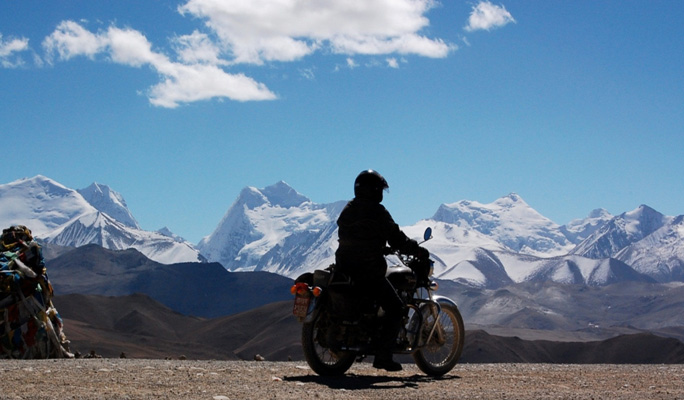
TIBET- “Roof of the World” A sacred land of myths and mysteries inhabited by the ever smiling people, has not only exerted a magnetic pull upon travelers for centuries but also spies, missionaries, scholars, geographers, mystics, soldiers and cranks, etc. Yet, only a few intrepid, serious and determined have been able to make it.
Tibet was opened to tourism in 1985. Before this, it avoided influence from the West and this country developed its unique culture and religion independently. Since Tibet was governed by the spiritual leaders, monasteries and religious institutions were the backbone of power so the importance and prestige were shown by the size and magnificent architecture of these buildings. Tibetan Buddhism contains many elements of their older religion,” Bon Po” which worshipped the sky, moon, sun, fire, soil and even evil spirits and this is why a monastery such as Tashilhunpo contains thousands of unique statues, paintings (thangka), religious and historical books that to visit in detail would take weeks. The Monasteries are crowded by pilgrims who often travel long distances to fulfill their vows and wishes and their emotions show that religion still holds a very important place in their daily lives.
Features
TIBET- extremely remote and isolated by the most formidable Himalayan ranges is a fascinating world of timeless splendor, unique tradition and breathtaking scenery awaits all travelers to the Roof of the World.
Full name: Tibet Autonomous Region of China
Area: 1.2 m. sq. km
Population: 3 million
In Exile: 300,000
Capital city: Lhasa (Population 200,000)
People: Tibetan & Chinese
Language: Tibeto Burmese, Tibetan and Chinese
Religion: 90% Buddhist, 1% Muslim, 3% bon, 6% others
Government: Occupied by China in 1949/1950
Currency: Yuan (Y 8.15 = US$ 1.00)
Geography: Tibet has border with India, Nepal, Sikkim, Bhutan and Burma
Climate: Spring (May to June) – Best weather condition, May to Mid September Winter – (October to April)
What to wear: Light weight clothing is recommended for May to June, Warm garments are required from September to April. An umbrella or a raincoat is a must for the summer season.
Voltage: Standard voltage only 220 volts.
DETAILED ITINERARY
Day 01: Arrive Kathmandu
Upon arrival in Kathmandu met by the representative and transfer to the hotel.
Rest of the day is free to relax.
Eve: A brief introduction of the trip and introduction of the participants of the ride followed by a welcome dinner at an authentic Nepali Restaurant.
After the dinner, transfer to the Hotel.
Overnight at the Hotel
Day 02: Sightseeing Tour of Kathmandu (Visa Processing Day)
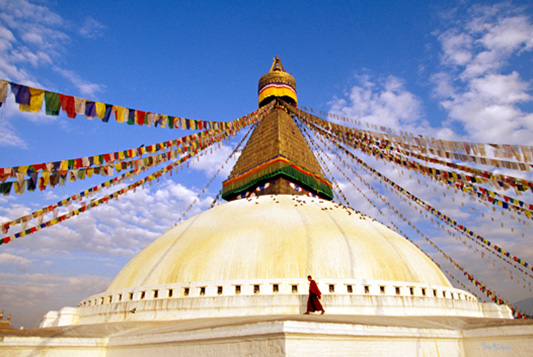 09:00 Hrs: After breakfast met by guide and vehicle for half a day’s sightseeing tour of Boudhanath Stupa and Pashupatinath Temple.
09:00 Hrs: After breakfast met by guide and vehicle for half a day’s sightseeing tour of Boudhanath Stupa and Pashupatinath Temple.
The Boudhanath Stupa is located 6 kilometers Northeast of Kathmandu and is a colossal imposing Stupa standing about 36 meters and is one of the oldest Buddhist monuments ever built in Nepal. The Stupa stands on the massive three level Mandala style platforms surrounded by colorful family style houses. The Stupa is said to have been built in the 5th Century and is a sight of great veneration to the Buddhist.
Continue on to Pashupanath Temple - the most sacred of the Hindu Temples in the world and is amongst the five principle pilgrimage sites for the Hindus. On an annual pilgrimage during Shivaratri Festival, thousands of devotees of Lord Shiva from all the Hindu communities of the world, pay their homage here.
Pashupatinath is the reincarnation of Shiva in his most benevolent form as the shepherd of fertility and so there are no animal sacrifices in this temple. Only fruits, flowers and vermilion are offered. It lies on the banks of the Bagmati river and for the Hindus, to be cremated at Pashupatinath, means a direct passage to heaven.
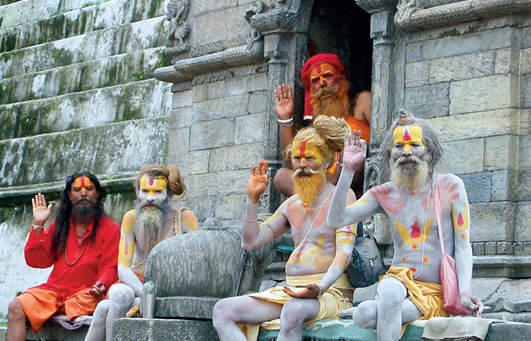 After the visit, return to the Hotel.
After the visit, return to the Hotel.
18:00 Hrs: Met by the Tour Escort and there will be a short briefing about the safety and the proper speed to ride on the roads of Nepal and Tibet followed by a question and answer session.
Rest of the evening is free
Overnight at the Hotel
Day 03: Ride Kathmandu to Syabrubesi (approx. 117 Km)
 Negotiate traffic out of the Kathmandu city to the Ringroad cross section - Balaju. From here, follow the Nagarjun highway to Kakani with the winding and narrow forested road.
Negotiate traffic out of the Kathmandu city to the Ringroad cross section - Balaju. From here, follow the Nagarjun highway to Kakani with the winding and narrow forested road.
We will have a short break here to see the beautiful mountain views.
From here it is a steep winding descent till Trishuli but the scenery is fantastic. Deep forested areas, with clear flowing streams and waterfalls provide visitors of what Nepal is all about.
Trishuli - The beauty of the area is not easily forgotten. The rolling hills, the trishuli river, ethnic villages, suspension bridges all make it a very interesting ride.
Here we stop for the lunch.
After lunch head north and continue ride to Dhunche.
From here steep descend on a winding and snaky trail till Syabrubesi.
Upon arrival at Syabrubesi check in to the lodge.
Rest of the day is free to relax or explore around the village.
Overnight at the Lodge
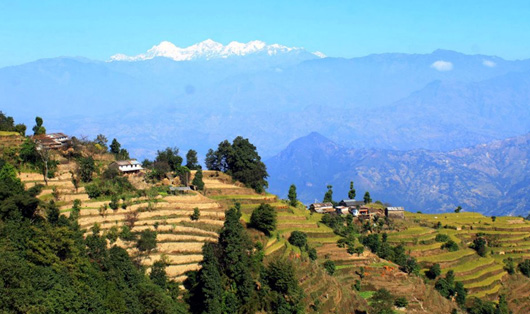
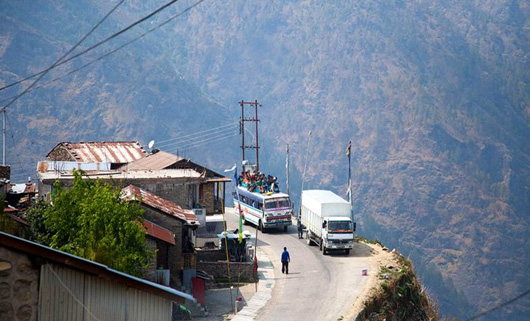
Day 04: Ride to Syabru besi to Kyirong Town (2700m) (Approx. 44 Km)
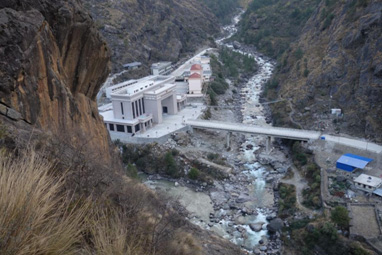 After breakfast ride approx. 20 Km to Kyirong - Nepal / Tibet border, the last border town, complete Nepali Immigration formalities and cross the friendship bridge. Complete Chinese Immigration and met by guide and driver from Tibet. Proceed for China Custom clearance for the motorcycles and after completion, load up the gear on the waiting Landcruiser / Mini Truck and ride for another 24 kilometer to Kyirong town.
After breakfast ride approx. 20 Km to Kyirong - Nepal / Tibet border, the last border town, complete Nepali Immigration formalities and cross the friendship bridge. Complete Chinese Immigration and met by guide and driver from Tibet. Proceed for China Custom clearance for the motorcycles and after completion, load up the gear on the waiting Landcruiser / Mini Truck and ride for another 24 kilometer to Kyirong town.
Kyirong, one of the frontier counties of Tibet Autonomous Region, lies in the southwest of Tibet and the southwest of Xigaze prefecture, covering 9,126 square kilometers with a population of 10 thousand. kyirong means in Tibetan happy village. kyirong Town is one of the important towns in Kyirong County, with a sea level of 2,700 meters. Pagba Monastery, Chagar Monastery and Qiangzhen Monastery are main monasteries of Kyirong and kyirong Jiangcun Nature Reserve is the famous beauty spot.
Up to 1960 one of the main trade routes between Nepal and Tibet passed through this region. Easily accessible from Nepal, it was used several times as an entrance gate for military actions from the site of Nepal against Tibet.
Upon arrival check in to the Hotel.
Rest of the day is free to relax or explore around the town to acclimatize.
Overnight at the Hotel
Day 05: Ride to Kyirong Town to Saga (4500m)(Approx. 170 Km)
After breakfast, ride through the beautiful Tibetan landscape. We enter a valley and the climb to a pass and then again descend into another valley one after another and each one more scenic than the next. Finally after about 3 ½ hours, we get a glimpse of the mighty Brahmaputra river or locally known as “Tsang Po” and ride along its banks for a while and take the bridge (newly constructed. In the earlier years, all passengers and vehicles had to be ferried across) to arrive at the hustle and bustle of the Saga town.
Upon arrival check in the guest house.
Rest of the day is free to relax or explore around the town.
Overnight at the Hotel
Day 06: Ride Saga / Shakya (4280m) (Approx. 323 km)
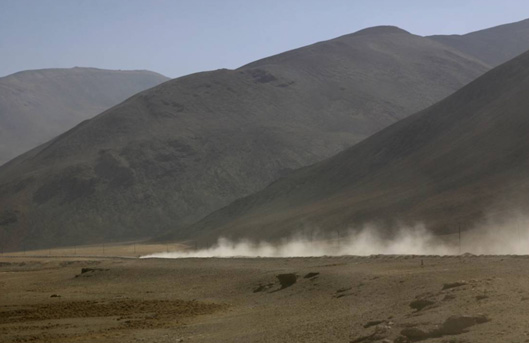 Start the scenic ride from Saga to Sakya crossing over 5 passes, Heading to Sakya from an elevation of 4600 meters, the trail wends towards the South route. Now, the trail follows a route that brushes past Brahmaputra River. Further ahead, a river valley sprawls over and then traditional picturesque villages come into picture and Namring being one of the biggest. This scenically rewarding ride provides plenty of opportunities for photography. On this long day’s ride over the sandy and rocky landscape of Tibet, other sites like lake, nomads chasing hundreds of yaks and sheep, keep you busy.
Start the scenic ride from Saga to Sakya crossing over 5 passes, Heading to Sakya from an elevation of 4600 meters, the trail wends towards the South route. Now, the trail follows a route that brushes past Brahmaputra River. Further ahead, a river valley sprawls over and then traditional picturesque villages come into picture and Namring being one of the biggest. This scenically rewarding ride provides plenty of opportunities for photography. On this long day’s ride over the sandy and rocky landscape of Tibet, other sites like lake, nomads chasing hundreds of yaks and sheep, keep you busy.
Upon arrival at Lhatse continue further 26 km to Shakya.
Upon arrival at Shakya check in to the Hotel.
Overnight at the Hotel
Day 07: Ride Shakya / Gyantse (3950m) (Approx. 250 km)
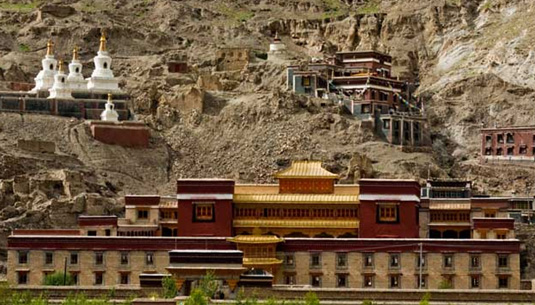 After breakfast visit Sakya Monastery, the centre of the Sakya order of Tibetan Buddhism, was founded in 1073 by Konchok Gyalpo and during the rule of Sakyapas, the priest patron relationship between Tibet and China was established. Sakyapa rulers reigned over Tibet for nearly a hundred years from 13-14th century. Many of its priceless images, fresco statues, Holy Scriptures remaining today date back to the time of its founding.
After breakfast visit Sakya Monastery, the centre of the Sakya order of Tibetan Buddhism, was founded in 1073 by Konchok Gyalpo and during the rule of Sakyapas, the priest patron relationship between Tibet and China was established. Sakyapa rulers reigned over Tibet for nearly a hundred years from 13-14th century. Many of its priceless images, fresco statues, Holy Scriptures remaining today date back to the time of its founding.
Later head off for 115 kilometers flat stretch to Shigatse. The route today is scenic with only a small pass of 4300 m. Upon arrival on the outskirts of the Shigatse City, we stop for lunch at a local restaurant.
After lunch, continue on to Gyantse. The 90 kilometer journey seems like hours because of the 40 kmph speed limit imposed by the traffic police. There are regular check posts as well as Patrol cars to strictly implement the rule.
Gyantse is a pastoral town and still retains the charm of a traditional Tibetan town untouched by modern expansion. It made world headlines in 1904 when Colonel Young husband, who led British Expedition to Tibet, defeated the Tibetan army there. As a crossroad on the principle trade route to India, it used to be renowned for the excellence of its carpets. The compound, encircled by an impressive wall, once contained 19 monasteries, presided over by the still intact fortress perched atop a nearby mountain.
Upon arrival, check into the hotel.
Late PM: Sightseeing tour of Gyantse Kumbum, one of the most unique and magnificent buildings in Tibet consisting of 6 storeys complete with a Buddhists Hall and a prayer hall. It has 112 chapels and its walls are adorned with religious paintings. Built in the 15th century, it has withstood all battles and revolutions since. We also visit the Pelkhor Chode Monastery located near the Khumbum, it was founded in the 15th century. It has been remarkably well preserved and many of the statues and paintings inside it date back to the time of its founding.
Overnight at the Gyantse Hotel
Day 08: Gyantse / Lhasa (3,650m): 261 Km via Lake Yamdrok.
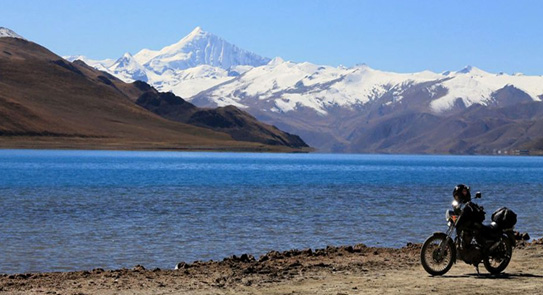 Set out of Gyantse for Nagartse (100 kms) near Lake Yamdrok passing the Simi La (4200 m) and driving on a trail with fantastic views of the turquoise blue waters of the man made lake caused by the dam for the hydro project. Later we also cross the Karo La (5010 m) and the ride to Nagartse, a small village near the Yamdrok lake and an ideal place for a lunch stop.
Set out of Gyantse for Nagartse (100 kms) near Lake Yamdrok passing the Simi La (4200 m) and driving on a trail with fantastic views of the turquoise blue waters of the man made lake caused by the dam for the hydro project. Later we also cross the Karo La (5010 m) and the ride to Nagartse, a small village near the Yamdrok lake and an ideal place for a lunch stop.
Then ride along the picturesque trail of the colorful Lake Yamdrok, the Tibetan lifeline of the river Brahma Putra (Yarlung Tsangpo). Yamdrok Tso or Turquoise Lake is a lake of a glaring blue that radiates a near mystical charm. It is about 240 kms in circumference and is more like an Island sea. There are Yak herders around and the lake itself supports a population of scale less fish in its non-saline waters. It is about 124 km from Lhasa.
Later we ascend to Kamba La (4,794m) and have an opportunity to meet the Yak Herders with their finely decorated Yaks and Tibetan Mastiffs. A great photo opportunity and one can take pictures on a Yak or with a bunch of decorated Tibetan Mastiffs for a fee.
From here we descend to the main road head before embarking on the grand finale entrance to the Lhasa City.
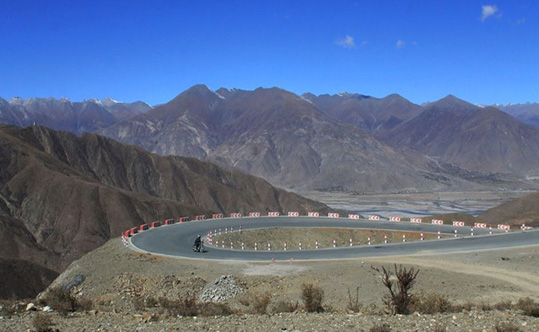 Lhasa - capital of Tibet at an altitude of 3650m is situated on the north bank of the Kyichu River in the province of U (central Tibet). Two high craggy hills stand up in isolation from the valley floor. One, Red Hill, is topped by the Potala Palace and the other, Chockpori or Iron Hill, is crowned by a tall antenna. Lhasa in Tibetan means "Place of the Gods" and Potala Palace " the residence of the Dalai Lama (the god king), is the earthly representation of the celestial Palace of Avaloketswora, the Buddha of infinite compassion whose incarnation in the human form is believed to be the Dalai Lama. As Tibet’s political, religious and cultural centre it is a city truly blessed by the gods, where life is unhurried, is people jovial and yet remaining staunchly independent.
Lhasa - capital of Tibet at an altitude of 3650m is situated on the north bank of the Kyichu River in the province of U (central Tibet). Two high craggy hills stand up in isolation from the valley floor. One, Red Hill, is topped by the Potala Palace and the other, Chockpori or Iron Hill, is crowned by a tall antenna. Lhasa in Tibetan means "Place of the Gods" and Potala Palace " the residence of the Dalai Lama (the god king), is the earthly representation of the celestial Palace of Avaloketswora, the Buddha of infinite compassion whose incarnation in the human form is believed to be the Dalai Lama. As Tibet’s political, religious and cultural centre it is a city truly blessed by the gods, where life is unhurried, is people jovial and yet remaining staunchly independent.
Lhasa consists of two district parts consisting of different architecture, population and lifestyle. Old Lhasa, the Tibetan section, centers around the Jokhang Temple. Its streets are narrow, between white washed stone houses whose walls slope inward as they rise. Windows are framed in black trapezoids, with protruding fan shaped eaves above. Many houses have brightly painted woodwork. The Chinese section, was built in the last 30 years around the base of the Potala. It is characterized by straight, broad streets and utilitarian buildings that houses Chinese style department stores and all kinds of government houses.
In spite of its forced pace of modernization, Lhasa has not lost it’s soul. It is a friendly city where a Tibetan will always return a smile.
Overnight at the Hotel
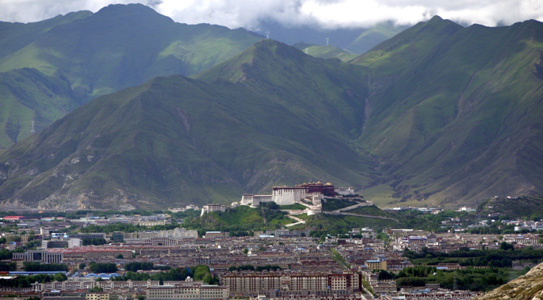
Day 09: Lhasa
After breakfast meet the representative and proceed for the sightseeing tour of Potala palace.
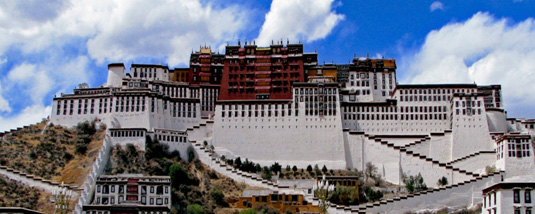 Potala Palace - this architectural wonder, a spectacular edifice whose gold roofs soar high above the town and rises more than 300 meters above the valley floor can be seen from all directions for miles around. The present Potala was built mainly in the Fifth Dalai Lama's reign between1645-1693 and remained the centre of political and religious power for the Dalai Lamas.
Potala Palace - this architectural wonder, a spectacular edifice whose gold roofs soar high above the town and rises more than 300 meters above the valley floor can be seen from all directions for miles around. The present Potala was built mainly in the Fifth Dalai Lama's reign between1645-1693 and remained the centre of political and religious power for the Dalai Lamas.
With over 1000 rooms, it contained the living quarters of the Dalai Lamas while they lived, and their magnificent golden tombs when they died. Regents, tutors and other high lamas had apartments in the palace too. The Potala held the offices of government, a huge printing house and a seminary run by the elite order of monks who surrounded the God-King to train government officials. Hundreds of elaborately decorated chapels and shrines, halls and corridors contain thousands of gilded statues - Tibet's pantheon of Buddhas, Boddisattvas, saints and demons.
Today the Potala is a statue museum with 35 caretaker monks, but too many thousands of Tibetan pilgrims, it remains a beloved shrine.
PM: Lunch, after lunch proceeds for the sightseeing tour of Jokhang Temple.
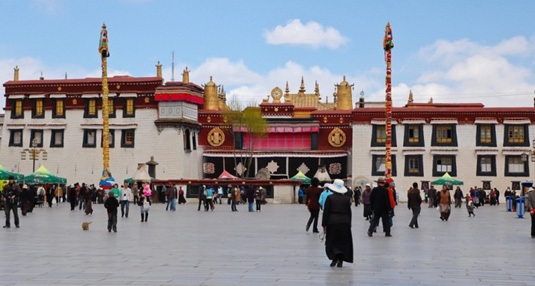 Jokhang Temple: Situated in the heart of old Lhasa, it houses Tibet’s most precious religious relic, a golden Shankyamuni Buddha which was brought as a gift by the Chinese Princess Wen Cheng on the occasion of her wedding to the Tibetan King, Songtsen Gompo. JOKHANG is the spiritual centre of Tibet, its mostly holy place, the destination, over time, of millions of Tibetan pilgrims. Its oldest part dates back from the 7th century A.D. Legend says that Songtsen Gampo, who built the temple, threw his ring into the air, promising to build a temple where it landed. The ring fell into a lake and struck a rock where a white stupa miraculously appeared - an auspicious sign.
Jokhang Temple: Situated in the heart of old Lhasa, it houses Tibet’s most precious religious relic, a golden Shankyamuni Buddha which was brought as a gift by the Chinese Princess Wen Cheng on the occasion of her wedding to the Tibetan King, Songtsen Gompo. JOKHANG is the spiritual centre of Tibet, its mostly holy place, the destination, over time, of millions of Tibetan pilgrims. Its oldest part dates back from the 7th century A.D. Legend says that Songtsen Gampo, who built the temple, threw his ring into the air, promising to build a temple where it landed. The ring fell into a lake and struck a rock where a white stupa miraculously appeared - an auspicious sign.
Surrounding the Jokhang Temple is the bustling Barkhor market place which is the religious and social focus of Lhasa. This, the spiritual centre of Tibet, is also the heart of Lhasa.After visiting Jokhang Temple proceed for the sightseeing tour of Ramoche Temple.
EVE: After sightseeing tour of board the waiting vehicle and drive towards the hotel. Rest of the evening is free to relax.
Overnight at Hotel
Day 10: Ride Lhasa to Lhatse (Approx. 375 Km)
After breakfast set out for Shigatse via the northern route. The route today is relatively straight forward but scenic at times when we ride along the Yarlung Tsangpo (Brahmaputra River).
Upon arrival at Shigatse, we do not enter the city premises but continue on the outskirts and head off for Lhatse passing through Gangchen and Silung, a distance of about 115 kms.
Upon arrival check in to the guest house.
Overnight at the Hotel
Day 11: Ride Lhatse to Rongbuk (Approx. 255 Km)
From Lhatse we ascend to the Gyatso la pass at 5248 m, the highest pass on this section of the journey, which is marked by a gate adorned with prayer flags. From here we descend to Shegar. It is surrounded by mountains and is another town that lies in the shadow of a great fortress. Even in ruins, it is majestic. Seeming to grow out of the craggy brown rock, it’s sinuous wall bristles with watchtowers like stegosaurus spines. Isolated in 1855 by marauding Nepalese in search of booty, the Gurkhas cut off the dzong’s water supply and settled in for a long siege. Shegar proper has little to recommend, except the highest post office in China.
Note: The main highway to Everest from Shegar is closed for repairs and is expected to re-open only form October 2015. Therefore all vehicles travelling to Everest Base Camp must travel through Tingri and return the same route until the main highway is complete.
From Shegar, set out for Tingri but within 4 kilometers we need to stop at an army check post where passports and permits are checked. Everyone is required to present their passport personally and in serial number as in group Visa. After the completion, return back to the vehicles and then ride 60 kms to Tingri.
Tingri use to be and important trading post where Sherpas from Nepal exchanged rice, grain and iron for Tibetan wool, livestock and salt. It gives its name to the broad upland basin more than 4,500 metres high that is known as the Tingri plain. Shallow, fast-flowing rivers of melted snow water make its grassy meadowland ideal for grazing by livestock.
From here come out on the main road and slowly negotiate traffic to the sign post which points to the Quomolongma (Everest) National park. Take the fork here and proceed to the check post where upon presenting the permits and tickets of the Everest Base Camp, one is let through the barrier.
This section of the route to Everest Base Camp is graveled (work is in progress), is dusty and a very rough one. As we ascend and descend from one valley into the other, there are fantastic views of the snow peaked mountains (weather permitting) of the rugged terrain of the high Himalayas.
Sulkily breathing dust and leaving a dust trail, we descend to the valley floor and join up with the main trail from Shegar. The construction works for a new paved road is underway and as we follow the Drakar Chu and slowly ascend winding our way up the mountain, we arrive at another check post with views of Mt. Everest peeking above the clouds and then a further climb of about 2 kilometers brings us to a turn in a bend and also to the Rongbuk Monastery and the Lodges of Rongbuk. In the distance, towering above everything else is Mt. Everest – Mother of the earth at 8848 m.
Upon arrival, check into the Guest House.
Dinner and Overnight at the guest house
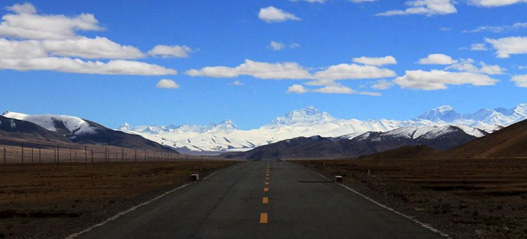
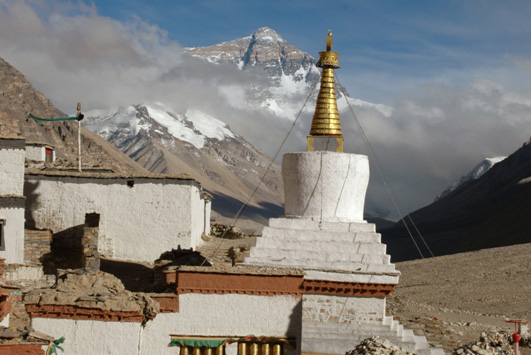
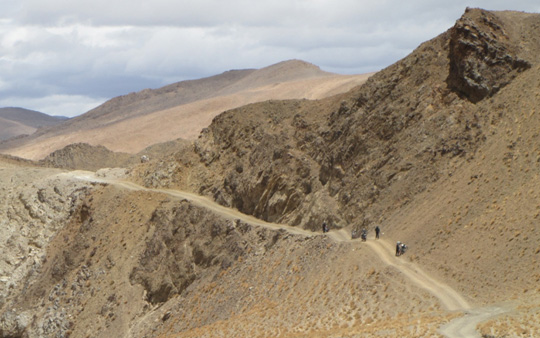
Day 12: Excursion around Mt. Everest Base Camp and Ride to Tingri
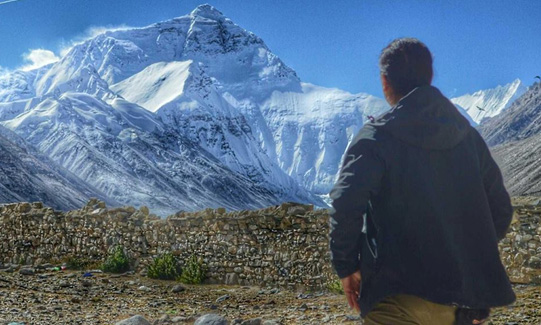 After breakfast, follow the dirt road south and the Dzakar Chu (river), now much reduced in volume, is on your right. Soon the valley broadens and the road leaves the river to continue its ascent on the other side, swerving to avoid a rockslide. At the base of the slide is chorten; at its top are the ruins of the Samdrupo Nunnery (a small chapel has been rebuilt). Here is now situated the settlement of Dza Rongphu. The Everest Base Camp settlement has now been moved here. The Everest Base Camp is just beyond some moraine hills. The rest of the afternoon is free to explore this area and enjoy this tented town.
After breakfast, follow the dirt road south and the Dzakar Chu (river), now much reduced in volume, is on your right. Soon the valley broadens and the road leaves the river to continue its ascent on the other side, swerving to avoid a rockslide. At the base of the slide is chorten; at its top are the ruins of the Samdrupo Nunnery (a small chapel has been rebuilt). Here is now situated the settlement of Dza Rongphu. The Everest Base Camp settlement has now been moved here. The Everest Base Camp is just beyond some moraine hills. The rest of the afternoon is free to explore this area and enjoy this tented town.
(Note: The new rules prohibit vehicles from going beyond Dza Rongphu area. Clients need to travel by the Government coach and it costs Yuan 50.00 for a round trip Ride).
So board the coach for the 4 kilometer Ride to the Everest Base Camp area. Here we embark and then ascend to a small ridge with prayer flags and with an unobstructed view of Mt. Everest and the open Tibetan plateau leading to the Camp II area.
Later descend to the Bus Park and board the bus for the Ride back to Dza Rongphu. Here we can spend some time at the tented city for a cup of tea/ noodle soup or shop for souvenirs or even send a post card from the mobile post office.
Later set out of Rongbuk by retracing the route till the 26 kilometer mark and then cross the bridge and head off with a steady climb to Tingri which takes about 4 hours.
Upon arrival check in to the guest house.
Rest of the day is free to relax or explore around the town.
Overnight at the guest house
Day 13: Ride Tingri to Kyirong Town (approx. 286 Km)
From Tingri we Ride on the highest plateau of the world with typical view of the Tibetan landscape offering sheer feeling of standing on the roof of the world. Cross the Lalung La (5,200m) and Thong La (5050 m) from where, weather permitting, here is a breathtaking panorama of beautiful Himalayan ranges including Mt. Everest (8,848m) but is dwarfed by the vastness of the Tibetan plateau.
The road passes through the desolate plain of Digur Tang with its enormous sand dunes and the snowcapped peaks of Shishapangma (8012m.) and Langtang (7232m.) in close proximity to the south. Leaving the Bum- Chu basin we descend towards Pelkhu Tso (4600m.) a stunningly beautiful lake into which the glacial streams of Da-Chu and Lha-Chu drain.
After spending some time at lake continue ride to Kyirong Xian. From here continue ride towards Kyirong Town (approx. 70 Km).
Upon arrival check in to the Hotel.
Rest of the day is free to relax or explore around the town.
Overnight at the Hotel
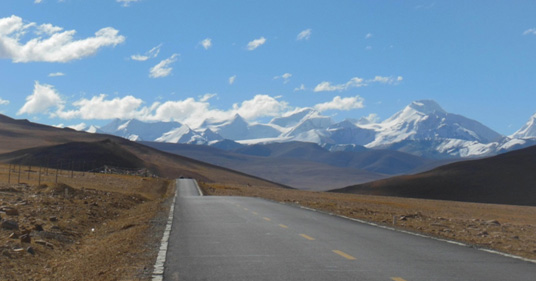
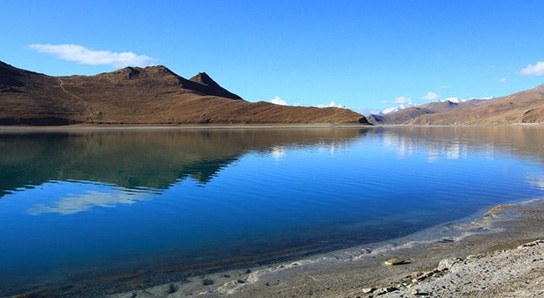
Day 14: Ride Kyirong Town to Kathmandu (Approx. 161 Km)
After breakfast ride down 24 kilometers to the border and the Nepal Tibet Friendship Bridge. Here the porters will transfer the luggage to the Nepal side and we bid farewell to our Guide and riders from Tibet. Complete Chinese Immigration and then cross the friendship bridge.
Met by representatives from Nepal who will assist to complete Nepal Customs and Immigration and ride 137 Km to Kathmandu.
Upon arrival at Kathmandu check in to the hotel.
Rest of the Day is free to relax.
Overnight at the Hotel
Day 15: Free Day in Kathmandu
Free day to relax or explore around the town for the final minute souvenir shopping.
EVE: Farewell Dinner
After dinner transfer to the hotel.
Overnight at the Hotel
Day 16: Final Departure
Free until final departure.
THE COST FOR THE JOURNEY TO TIBET
Duration: 15 Nights / 16 Days
THE COST STATED BELOW IS NET PER PERSON ON TWIN SHARING BASIS FOR THE MINIMUM OF 05 PAX TRAVELLING TOGETHER BASED ON US DOLLARS
The cost given below is for some idea. The current cost will be provided on request.
USING HONDA CRF 250 CC MOTORBIKE
No. of Pax:
05 Pax: US $ 6665.00
06 Pax: US $ 6054.00
07 Pax: US $ 5597.00
08 Pax: US $ 5266.00
09 Pax: US $ 5013.00
10 Pax: US $ 4787.00
Single Supplement: US $ 433.00
Pillion Rider Cost: US $ 3304.00
01 Trip Leader: FREE OF COST
USING ROYAL ENFIELD HIMALAYAN MOTORBIKE
No. of Pax:
05 Pax: US $6281.00
06 Pax: US $5674.00
07 Pax: US $5220.00
08 Pax: US $4891.00
09 Pax: US $4639.00
10 Pax: US $ 4415.00
Single Supplement: US $433.00
Pillion Rider Cost: US $3304.00
01 Trip Leader: FREE OF COST
THE COST INCLUDES:
- All transfer to and from Airport / Hotel / Airport in a private vehicle accompanied by an English Speaking representative.
- 04 Nights stay at Hotel Manaslu or similar in Kathmandu on Bed & Breakfast basis and inclusive of all applicable Govt. Taxes.
- Welcome dinner with transfer in a private deluxe non a/c vehicle accompanied by an English speaking representative.
- Sightseeing tour of Kathmandu as per the itinerary in a private vehicle accompanied by an English Speaking Guide.
- Hire of Motorbikes (Whichever applicable) for the entire trip.
- Fuel for the motorbikes.
- Services of an experienced Road Captain & Mechanic for the entire trip as per the itinerary inclusive of his wages, allowances, Visa fee and Tibet travel permits.
- 02 Backup vehicle (01 Jeep for pillion rider and emergency and 01 truck to carry luggage, support staff and spare parts) for the sector Kathmandu to Syabrubesi (Pre Ride) and Syabrubesi to Kathmandu (Post Ride).
- 01 night stay at local guest house in Syabrubesi on MAP basis (Dinner & Breakfast) and inclusive of all applicable Govt. Taxes.
- Poterages at the Rasuwa (Tibet border) to transfer the equipment and spare parts from Nepal side to Tibet side and vice versa pre and post Tibet Tour.
- Visa Fee for Tibet of USD 114.00.00 per person for all nationals except US nationals (subject to change without prior notice).
- Support of 4WD Jeep and a truck inside Tibet (Rasuwa / Lhasa / Rasuwa) to carry spare parts, luggage and guide.
- Documentation for Tibet travel permit and a special permit for Everest Base Camp.
- Services of a knowledgeable Tibetan Guide from Lhasa Agency.
- Permit for Motorcycles to enter Tibet and the Everest Base Camp region in Tibet, PRC
- The overnights stay at the mentioned places as per the itinerary will be in Guest house / Lodges and 3 star hotels with common baths and inclusive of daily breakfast.
- All lunch & Dinner at Hotels / Guesthouses OR local restaurants on en-route stopovers (in Tibet).
- Bus to Everest Base Camp and back from Rongbuk (as per the itinerary).
- Support of Oxygen canisters (Chinese make).
- Comprehensive Medical Kit.
THE COST EXCLUDES:
- International and Domestic Air Ticket.
- Nepal Visa Fee.
- Personal insurance and evacuation.
- Items of a personal nature such as bar bills, alcoholic beverages, bottled drinks and mineral water, extra mileage, personal gratuities such as tips to guides, riders and trek staff
- Cost for the damage / repair of motorcycles if any
- Items not mentioned in the cost includes
- Costs incurred due to natural calamities, strikes, breakdowns and beyond the control of Waypoint Adventures and its associates.
